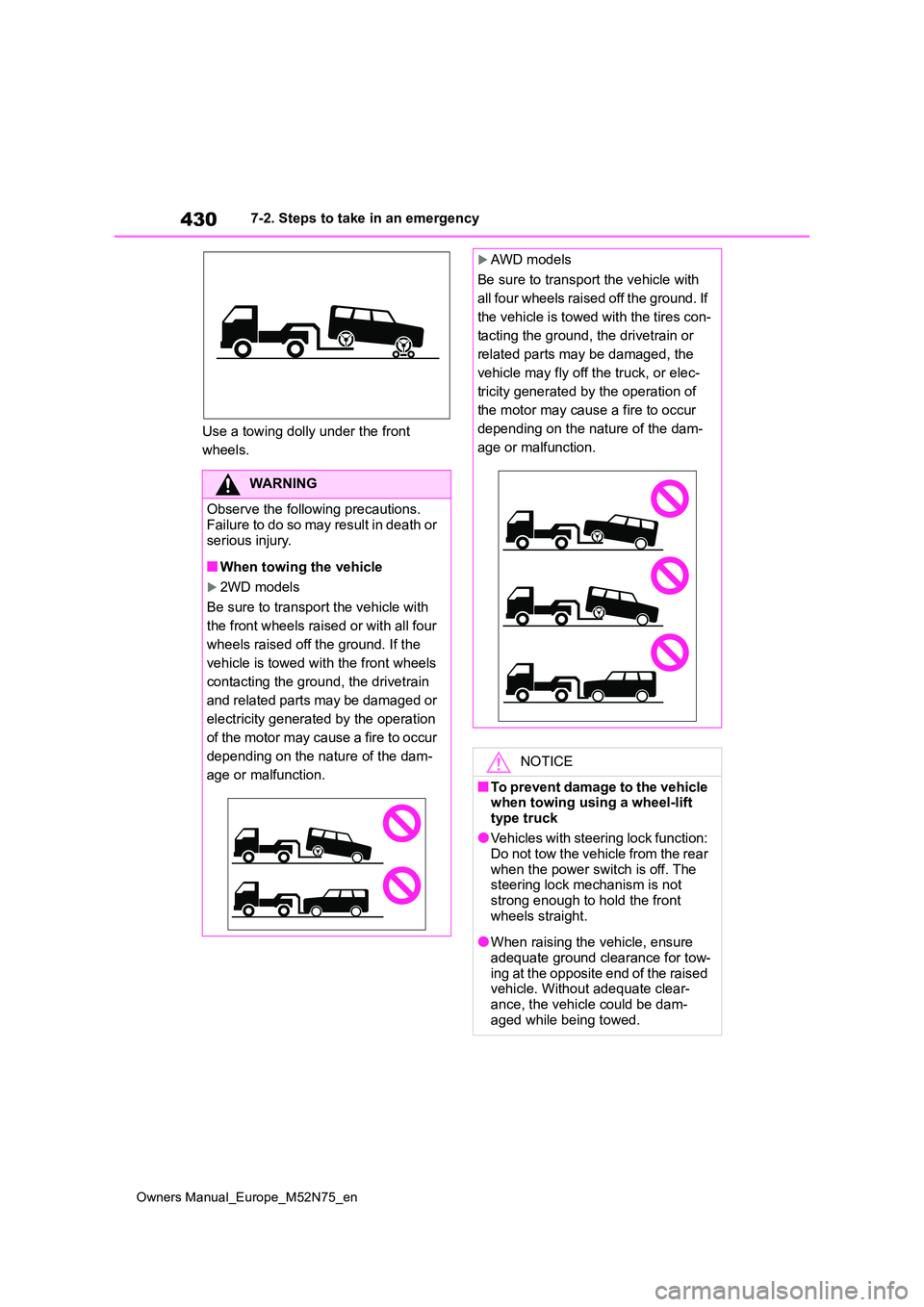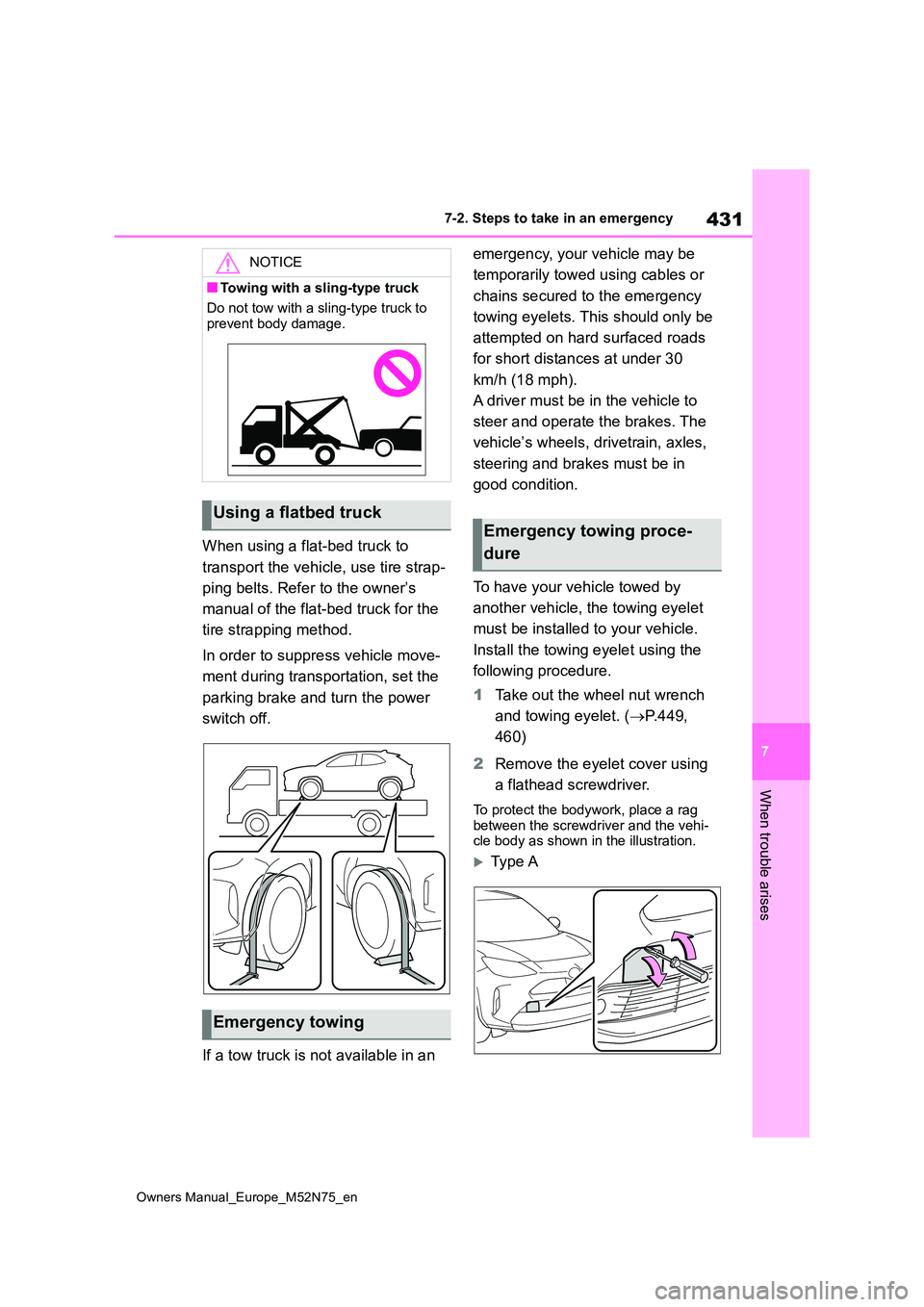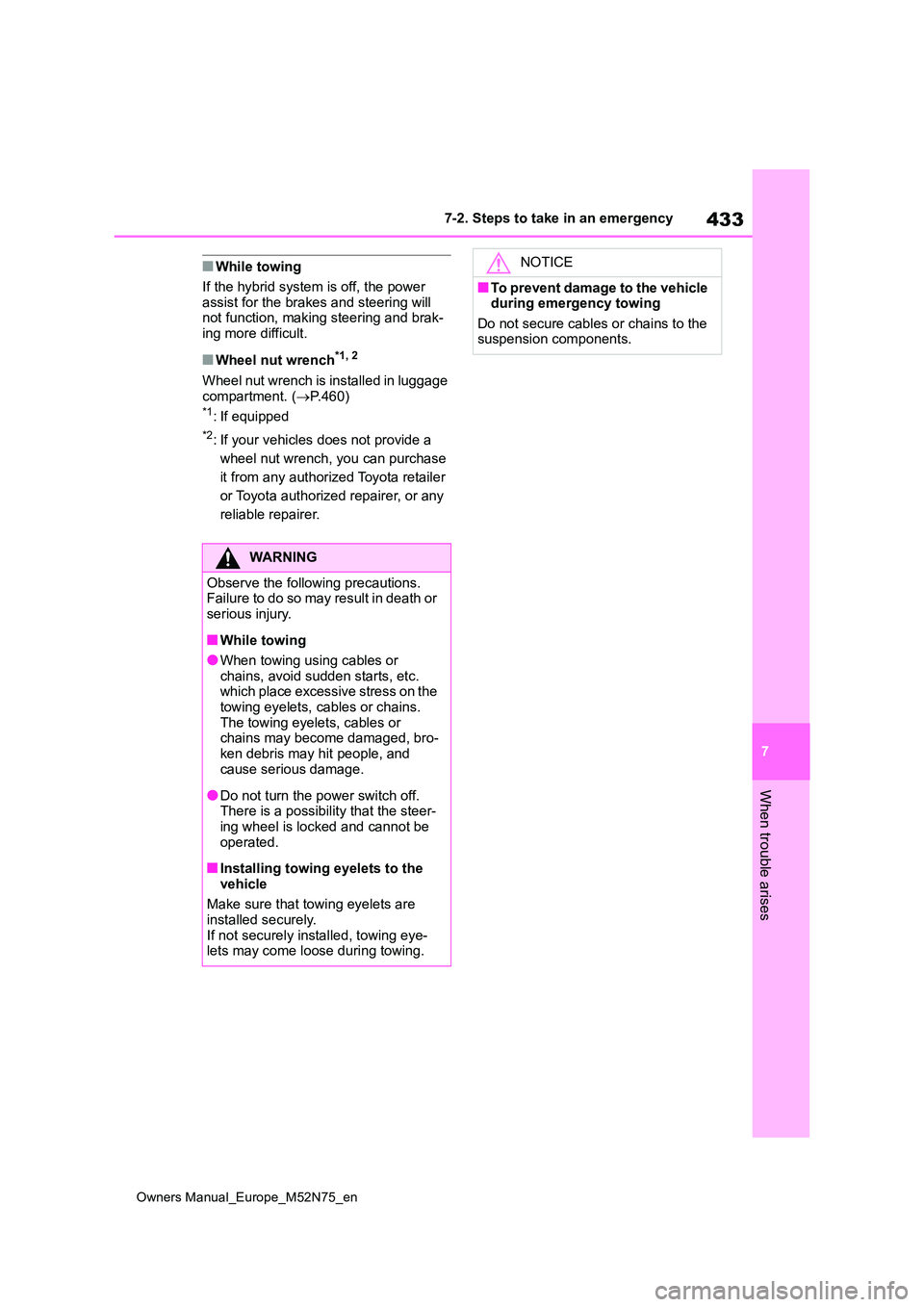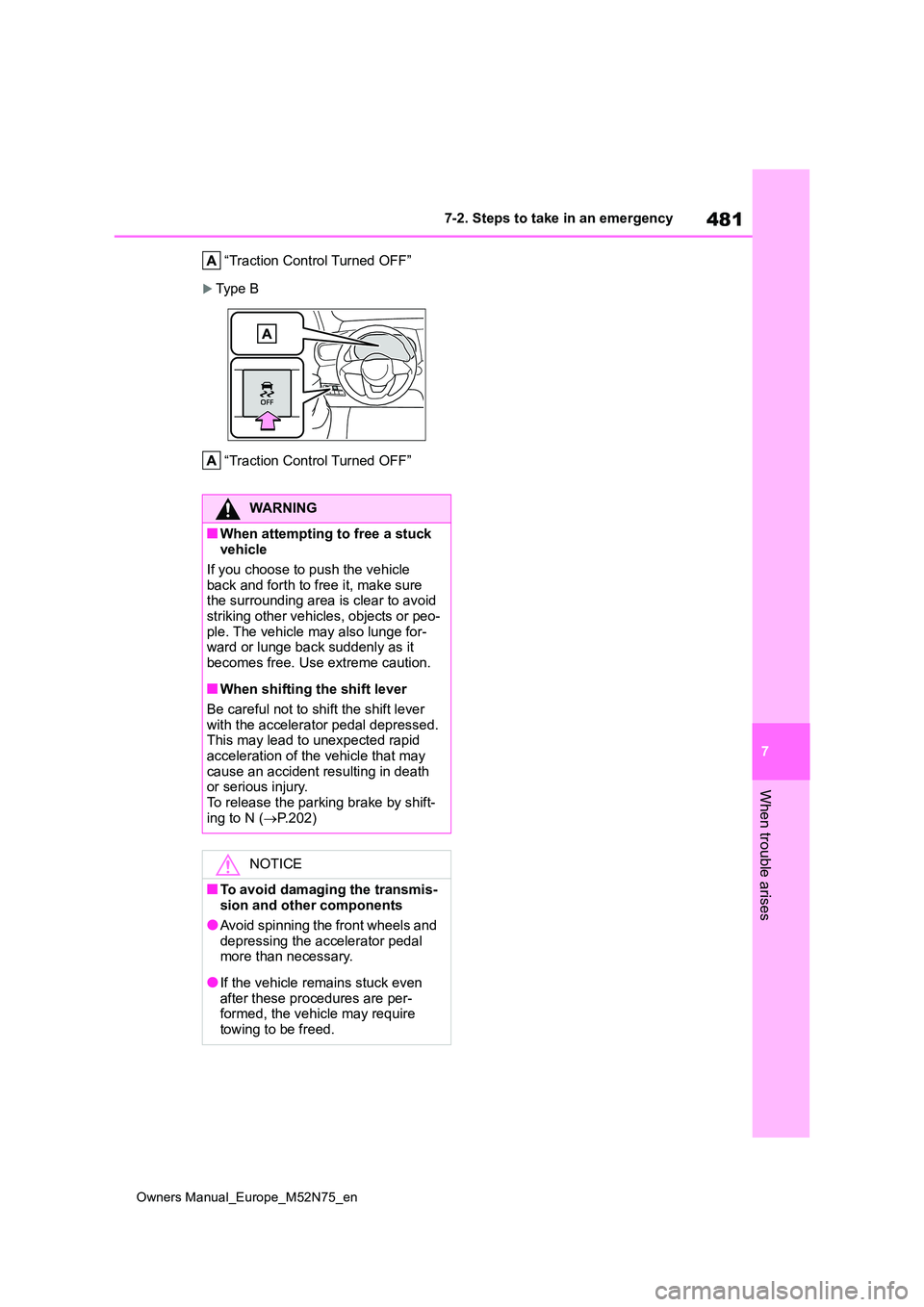Page 431 of 698

429
7
Owners Manual_Europe_M52N75_en
7-2. Steps to take in an emergency
When trouble arises
7-2.Ste ps to take in an emerg ency
The following may indicate a prob-
lem with your transmission. Contact
any authorized Toyota retailer or
Toyota authorized repairer, or any
reliable repairer or commercial tow-
ing service before towing.
The hybrid system warning mes-
sage is shown on the multi-infor-
mation display and the vehicle
does not move.
The vehicle makes an abnormal
sound.
From the front
2WD models
Release the parking brake.
Turn automatic mode off. ( P.201)
Do not open the driver door. If you open
the door, the parking brake automati-
cally locked.
When it is necessary to get out of the
vehicle with N range and parking brake
released
When getting out of the vehicle with N
range and parking brake released
( P.202).
AWD models
Use a towing dolly under the rear
wheels.
From the rear
If your vehicle needs to
be towed
If towing is necessary, we rec-
ommend having your vehicle
towed by any authorized
Toyota retailer or Toyota autho-
rized repairer, or any reliable
repairer or commercial towing
service, using a wheel-lift type
truck or flatbed truck.
Use a safety chain system for
all towing, and abide by all
state/provincial and local laws.
Situations when it is neces-
sary to contact dealers
before towing
Towing with a wheel-lift type
truck
Page 432 of 698

430
Owners Manual_Europe_M52N75_en
7-2. Steps to take in an emergency
Use a towing dolly under the front
wheels.
WARNING
Observe the following precautions.
Failure to do so may result in death or serious injury.
■When towing the vehicle
2WD models
Be sure to transport the vehicle with
the front wheels raised or with all four
wheels raised off the ground. If the
vehicle is towed with the front wheels
contacting the ground, the drivetrain
and related parts may be damaged or
electricity generated by the operation
of the motor may cause a fire to occur
depending on the nature of the dam-
age or malfunction.
AWD models
Be sure to transport the vehicle with
all four wheels raised off the ground. If
the vehicle is towed with the tires con-
tacting the ground, the drivetrain or
related parts may be damaged, the
vehicle may fly off the truck, or elec-
tricity generated by the operation of
the motor may cause a fire to occur
depending on the nature of the dam-
age or malfunction.
NOTICE
■To prevent damage to the vehicle when towing using a wheel-lift
type truck
●Vehicles with steering lock function: Do not tow the vehicle from the rear
when the power switch is off. The steering lock mechanism is not strong enough to hold the front
wheels straight.
●When raising the vehicle, ensure
adequate ground clearance for tow- ing at the opposite end of the raised vehicle. Without adequate clear-
ance, the vehicle could be dam- aged while being towed.
Page 433 of 698

431
7
Owners Manual_Europe_M52N75_en
7-2. Steps to take in an emergency
When trouble arises
When using a flat-bed truck to
transport the vehicle, use tire strap-
ping belts. Refer to the owner’s
manual of the flat-bed truck for the
tire strapping method.
In order to suppress vehicle move-
ment during transportation, set the
parking brake and turn the power
switch off.
If a tow truck is not available in an
emergency, your vehicle may be
temporarily towed using cables or
chains secured to the emergency
towing eyelets. This should only be
attempted on hard surfaced roads
for short distances at under 30
km/h (18 mph).
A driver must be in the vehicle to
steer and operate the brakes. The
vehicle’s wheels, drivetrain, axles,
steering and brakes must be in
good condition.
To have your vehicle towed by
another vehicle, the towing eyelet
must be installed to your vehicle.
Install the towing eyelet using the
following procedure.
1 Take out the wheel nut wrench
and towing eyelet. ( P. 4 4 9 ,
460)
2 Remove the eyelet cover using
a flathead screwdriver.
To protect the bodywork, place a rag between the screwdriver and the vehi-cle body as shown in the illustration.
Typ e A
NOTICE
■Towing with a sling-type truck
Do not tow with a sling-type truck to
prevent body damage.
Using a flatbed truck
Emergency towing
Emergency towing proce-
dure
Page 434 of 698
432
Owners Manual_Europe_M52N75_en
7-2. Steps to take in an emergency
Type B
3 Insert the towing eyelet into the
hole and tighten partially by
hand.
Type A
Type B
4 Tighten down the towing eyelet
securely using a wheel nut
wrench*1, 2 or hard metal bar.
*1: If equipped
*2: If your vehicles does not provide a
wheel nut wrench, you can purchase
it from any authorized Toyota retailer
or Toyota authorized repairer, or any
reliable repairer.
Typ e A
Typ e B
5 Securely attach cables or chains
to the towing eyelet.
Take care not to damage the vehicle body.
6 Enter the vehicle being towed
and start the hybrid system.
If the hybrid system does not start, turn the power switch to ON.
7 Shift the shift lever to N and
release the parking brake.
Turn automatic mode off. ( P.201)
Do not open the driver door. If you open
the door, the parking brake automati- cally locked.
When the shift lever cannot be shifted:
P. 1 9 8
Page 435 of 698

433
7
Owners Manual_Europe_M52N75_en
7-2. Steps to take in an emergency
When trouble arises
■While towing
If the hybrid system is off, the power
assist for the brakes and steering will not function, making steering and brak-ing more difficult.
■Wheel nut wrench*1, 2
Wheel nut wrench is installed in luggage compartment. ( P.460)*1: If equipped
*2: If your vehicles does not provide a
wheel nut wrench, you can purchase
it from any authorized Toyota retailer
or Toyota authorized repairer, or any
reliable repairer.
WARNING
Observe the following precautions. Failure to do so may result in death or
serious injury.
■While towing
●When towing using cables or chains, avoid sudden starts, etc. which place excessive stress on the
towing eyelets, cables or chains. The towing eyelets, cables or chains may become damaged, bro-
ken debris may hit people, and cause serious damage.
●Do not turn the power switch off.There is a possibility that the steer-ing wheel is locked and cannot be
operated.
■Installing towing eyelets to the
vehicle
Make sure that towing eyelets are installed securely.
If not securely installed, towing eye- lets may come loose during towing.
NOTICE
■To prevent damage to the vehicle during emergency towing
Do not secure cables or chains to the suspension components.
Page 452 of 698
450
Owners Manual_Europe_M52N75_en
7-2. Steps to take in an emergency
AWD models
Towing eyelet
Emergency tire puncture repair kit
Bottle
Nozzle
CompressorEmergency tire puncture
repair kit components
Page 462 of 698
460
Owners Manual_Europe_M52N75_en
7-2. Steps to take in an emergency
Tool bag
Wheel nut wrench
Jack handle
Towing eyelet
Spare tire
Jack
Location of the spare tire, jack and tools
WARNING
■Using the tire jack
Observe the following precautions.
Improper use of the tire jack may cause the vehicle to suddenly fall off the jack, leading to death or serious
injury.
●Do not use the tire jack for any pur-
pose other than replacing tires or installing and removing tire chains.
●Only use the tire jack that comes with this vehicle for replacing a flat tire. Do not use it on other vehicles,
and do not use other tire jacks for replacing tires on this vehicle.
Page 483 of 698

481
7
Owners Manual_Europe_M52N75_en
7-2. Steps to take in an emergency
When trouble arises
“Traction Control Turned OFF”
Typ e B
“Traction Control Turned OFF”
WARNING
■When attempting to free a stuck vehicle
If you choose to push the vehicle
back and forth to free it, make sure the surrounding area is clear to avoid striking other vehicles, objects or peo-
ple. The vehicle may also lunge for- ward or lunge back suddenly as it becomes free. Use extreme caution.
■When shifting the shift lever
Be careful not to shift the shift lever
with the accelerator pedal depressed. This may lead to unexpected rapid acceleration of the vehicle that may
cause an accident resulting in death or serious injury.To release the parking brake by shift-
ing to N ( P.202)
NOTICE
■To avoid damaging the transmis- sion and other components
●Avoid spinning the front wheels and
depressing the accelerator pedal more than necessary.
●If the vehicle remains stuck even after these procedures are per-formed, the vehicle may require
towing to be freed.